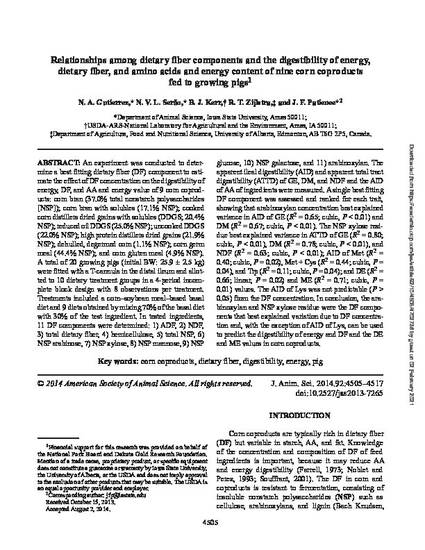
An experiment was conducted to determine a best fitting dietary fiber (DF) component to estimate the effect of DF concentration on the digestibility of energy, DF, and AA and energy value of 9 corn coproducts: corn bran (37.0% total nonstarch polysaccharides [NSP]); corn bran with solubles (17.1% NSP); cooked corn distillers dried grains with solubles (DDGS; 20.4% NSP); reduced oil DDGS (25.0% NSP); uncooked DDGS (22.0% NSP); high protein distillers dried grains (21.9% NSP); dehulled, degermed corn (1.1% NSP); corn germ meal (44.4% NSP); and corn gluten meal (4.9% NSP). A total of 20 growing pigs (initial BW: 25.9 ± 2.5 kg) were fitted with a T-cannula in the distal ileum and allotted to 10 dietary treatment groups in a 4-period incomplete block design with 8 observations per treatment. Treatments included a corn–soybean meal–based basal diet and 9 diets obtained by mixing 70% of the basal diet with 30% of the test ingredient. In tested ingredients, 11 DF components were determined: 1) ADF, 2) NDF, 3) total dietary fiber, 4) hemicellulose, 5) total NSP, 6) NSP arabinose, 7) NSP xylose, 8) NSP mannose, 9) NSP glucose, 10) NSP galactose, and 11) arabinoxylan. The apparent ileal digestibility (AID) and apparent total tract digestibility (ATTD) of GE, DM, and NDF and the AID of AA of ingredients were measured. A single best fitting DF component was assessed and ranked for each trait, showing that arabinoxylan concentration best explained variance in AID of GE (R2 = 0.65; cubic, P < 0.01) and DM (R2 = 0.67; cubic, P < 0.01). The NSP xylose residue best explained variance in ATTD of GE (R2 = 0.80; cubic, P < 0.01), DM (R2 = 0.78; cubic, P < 0.01), and NDF (R2 = 0.63; cubic, P < 0.01); AID of Met (R2 = 0.40; cubic, P = 0.02), Met + Cys (R2 = 0.44; cubic, P = 0.04), and Trp (R2 = 0.11; cubic, P = 0.04); and DE (R2 = 0.66; linear, P = 0.02) and ME (R2 = 0.71; cubic, P = 0.01) values. The AID of Lys was not predictable (P > 0.05) from the DF concentration. In conclusion, the arabinoxylan and NSP xylose residue were the DF components that best explained variation due to DF concentration and, with the exception of AID of Lys, can be used to predict the digestibility of energy and DF and the DE and ME values in corn coproducts.
Available at: http://works.bepress.com/john-patience/108/

This article is published as Gutierrez, N. A., N. V. L. Serão, B. J. Kerr, R. T. Zijlstra, and J. F. Patience. "Relationships among dietary fiber components and the digestibility of energy, dietary fiber, and amino acids and energy content of nine corn coproducts fed to growing pigs." Journal of Animal Science 92, no. 10 (2014): 4505-4517. doi: 10.2527/jas.2013-7265.